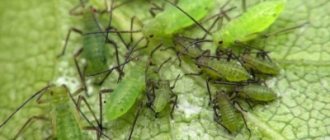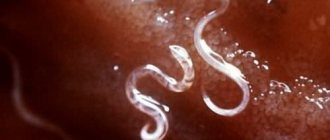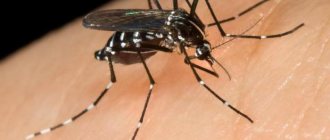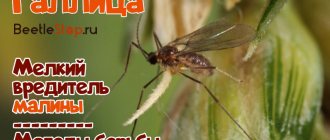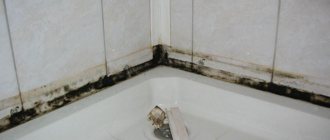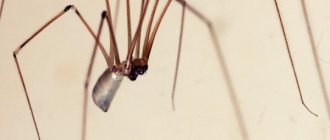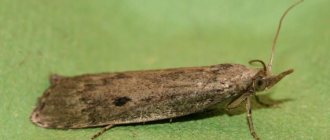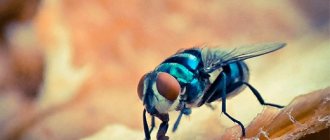A centipede is a representative of arthropods that belongs to the order Centipedes. Moreover, it is not an insect, as many people think, but an invertebrate animal! Centipedes live in almost all corners of the planet and number about 12 thousand species. In Russia you can most often find the common flycatcher. This is a small centipede with a body size of 3-5 centimeters and many thin long limbs. An adult has 15 pairs, with the last one being the largest. There are also long antennae on the head. Therefore, it is not always possible to determine where the head is and where the back of the body is.
A centipede in the house is not such a rare occurrence. It can start both in a private house and in an apartment. The publication will tell you why this happens and how to deal with it.
Reasons for appearing in the house
Knowing their habits and behavior will help you understand why there are centipedes in the house. In nature, these creatures live in damp places where there is an abundance of small insects - the main food of centipedes. With the arrival of winter, they begin to seek shelter from the cold and often wander into basements and people's homes. Flycatchers are even able to reach high floors through ventilation shafts and cracks in ceilings.
These animals are especially attracted to bathrooms, places under sinks and dark corners where spiders, cockroaches, ants and other small insects most often live. If there is a constant source of food and moisture, the flycatcher will live in the house for a long time and will even be able to reproduce successfully if other individuals are present.
That is, several factors contribute to the appearance of centipedes in the house.
- High humidity.
- Warm.
- Presence of insects.
- Darkness.
Fighting methods
Even though the flycatcher is dangerous to humans, not everyone wants to live next to such a multi-legged insect. The easiest way to remove it is to deprive it of access to food, that is, get rid of all other arthropod pests. Experiencing a lack of food, house flycatchers will leave their homes on their own in search of better conditions.
Mechanical method
The simplest way to get rid of a flytrap is mechanical. The insect can be killed with any hard object (unlike the scolopendra, it does not have a hard protective shell) or caught and then released into the street. Many people prefer the second option, since the centipede is very beneficial for the environment and depriving it of its life is considered a bad omen in many places.
Flycatchers are quite agile and hidden, so catching them is often difficult. It is better to use a transparent container for this - a glass or jar. They cover the uninvited guest from above, put a piece of paper or cardboard under the bottom, after which they take him outside the home and release him into the wild.
If there are a bunch of flycatchers in the house, then to get rid of them you need to understand why they found human habitation so attractive. Usually these insects crawl into the house by accident and do not find a sexual partner there, so they do not reproduce. When a whole flock appears in a living space, then in addition to them there are large colonies of pests in the house - cockroaches, termites, fleas, moths. In this case, you should not rush and poison flycatchers - it is better to direct your efforts to fight the main threat, and the unpleasant neighbors will eventually leave their home due to lack of food.
Folk remedies
If the number of insects is small, they can be scared away from the house using folk remedies. Two methods are used for this:
Boric acid. At the same time, it will repel flycatchers and other insects - almost all of them do not tolerate the effects of this substance. You can buy it at pharmacies or fertilizer stores. It is most convenient to use powdered variations, as they are easier to scatter and clean up. Acid is poured into insect habitats - under sinks, bathtubs, and toilets, in areas behind pipes, near cracks in floors and walls.
It is important to prevent its contact with medications and food products, as well as limit access to children and pets. When the centipedes disappear, it is necessary to carry out a thorough cleaning and wipe all bait areas with a rag with a disinfectant, and then ventilate the room
Red hot pepper. Several pods of this buggy plant need to be very finely chopped, dried and scattered in places where flycatchers run. Like boric acid, this seasoning is destructive to almost all apartment pests, but is not toxic to humans. It is worth clarifying that seasoning from the store will not work - you need a chopped pod, which you can make yourself or buy at the pharmacy.
https://youtube.com/watch?v=msxOAR0J_wo
Chemical removal
If you cannot remove flycatchers using conventional means, you can use insecticides. This is not recommended, since the use of toxic chemicals often causes more harm to humans than proximity to harmless (and even beneficial) flycatchers. Common drugs to combat multi-legged neighbors:
Aerosol "Rapid"
It should be sprayed on the walls in places where flytraps accumulate, paying special attention to crevices and hiding places. Before use, be sure to close windows and doors, and remove all food and medications from the premises.
While working, you should wear gloves and avoid getting the aerosol on your clothes or skin. "Combat MultiSpray". Unlike “Rapid”, it is used with open doors and windows. The spray is used to spray areas where insects accumulate or the surfaces on which they move. Only dry and non-absorbent surfaces can be treated, otherwise the product will lose effectiveness. Aerosol “Clean House”. It is sprayed on the walls, in the cracks and gaps between the baseboards, after which they leave the room for 2-3 hours, removing all people and pets from there and tightly closing the aquariums and terrariums. The second method of application is to spray the entire contents of the can in the center of the room for complete disinfection, but then you will not be able to go there for 2-3 days.
Conventional poisons and baits against flycatchers are ineffective - they prey on living insects, and therefore do not show interest in them. Sticky traps also do not work against them - arthropods disentangle themselves from them or tear off the stuck paw.
The flycatcher is a completely harmless and even useful insect for the home. To prevent it from bothering a person with its unpleasant appearance, it is enough to drive out the pests on which it feeds from the apartment.
Source
Is a centipede in the house dangerous for humans?
In general, centipedes are quite harmless creatures. They do not damage furniture, do not harm plants, and never attack people first. On the contrary, the flycatcher tries to hide back into the crack so as not to be touched. Only in rare cases, when she is in real danger, can she bite, injecting poison into the skin. But don't be afraid, he is very weak. Therefore, only slight redness occurs at the site of the bite. And then, the centipede is capable of biting through the skin of a small child and small pets. An adult is “too tough for her.”
That is, the question of whether centipedes are dangerous in the house can be answered in the negative. They do not pose a threat, but only scare away with their terrifying appearance. And so, living together with a flycatcher is very useful. She, being a predator, perfectly exterminates spiders, flies, midges, cockroaches, fleas, moths, silverfish, larvae and worms.
But not every owner, for various reasons, is able to come to terms with the fact that such a creature has appeared in his house. Therefore, people have come up with several ways to kill centipedes.
Habits, instincts and life of the flycatcher: the most interesting
You should know that the centipede (the photo will not allow you to make a mistake) is an insect that is equally active at any time of the day. Every hour, every minute she looks for prey. As soon as the victim is identified, the flycatcher injects a portion of a toxic substance into it to neutralize it and only after that it eats it without haste. The insect is very fast, capable of covering up to 40 centimeters in one second.
On average, a female flyeater lays up to 6 dozen eggs at a time. All of them are protected with a sticky substance and placed in a hole or deep crack carefully dug by mom. The insect carefully wraps its body around the clutch of eggs and tries to close it from the outside world with its paws. In this way, the scolopendra “nurses” the eggs for many weeks, without leaving the nest even a centimeter, and does not eat or drink anything.
The common centipede is an insect with a mission. Being a representative of the most ancient inhabitants of the planet, it deserves special attention. At first glance, scary and unpleasant insects actually provide invaluable assistance to humans by eating a lot of pests, for example:
- flies;
- cockroaches;
- fleas;
- ants;
- bedbugs, etc.
There are up to 8,000 species of this insect in the world, but only 3,000 of them have been officially documented, such as the Chinese centipede, which reaches a quarter of a meter in length with a body of 23 sections, or the bright black African centipede with a body up to 28 cm long!
Almost none of the discovered species of centipedes are dangerous to humans. Yes, arthropods can bite, but all that a centipede bite can do is cause allergies, and then only in people who are prone to this kind of reaction with a slight increase in temperature and swelling at the site of the bite.
In the insect world, the centipede is one of the dominant predators with claws on the first segment. She is a carnivore, so she prefers clean meat from small insects. Large species can cope not only with invertebrates, but also with small reptiles, as well as worms, frogs, spiders and even birds.
How to get rid of centipedes in the house?
The first thing that comes to mind when you see such a “miracle” in your home is to slap it with the first object you come across. Most often this becomes a slipper. But it is worth considering that the centipede is capable of restoring and regrow damaged parts of the body if it is not completely killed. It would be much more humane to catch a flycatcher in a jar and release it outside when it gets warmer.
This method is suitable if one or a pair of centipedes accidentally appeared in the house. If they have occupied the home thoroughly, then it is better to resort to more radical methods. Moreover, it is not necessary to use special drugs or toxic substances. Folk remedies are no less effective.
Visual differences of a centipede
To say that the flycatcher is an insect is not entirely correct. In fact, it belongs to the group of arthropods called tracheae. Its body consists of 15 segments, due to which it is held in one position. The legs become noticeably longer as they approach the rear part. The last pair of legs may be longer than the body itself. The special structure of the body allows the insect to move at the desired pace without touching its own legs.
Often long pairs of legs are confused with whiskers, causing confusion regarding the position of the head and tail. As a result of many years of living in an apartment, the ordinary domestic scolopendra has been somewhat modified - the front pair of its legs has transformed into a jaw. With its help, the insect gets to food in hard-to-reach places.
On the sides of the centipede's head there are eyes and so-called antennae-catchers consisting of several hundred segments. By analogy with locators, they monitor changes in the environment, help explore space, react to temperature changes, and become a guide in finding comfortable and safe places.
Every common flycatcher in nature has a serious enemy - a snake.
In addition, insects become victims of cats and rats, although in the first case such a hunt for a pet can have unpleasant consequences, since centipedes are carriers of parasites.
Eliminate moisture
The main reason why centipedes appear in the house is the abundance of moisture. Once you get rid of it, the flycatchers will leave to look for a more suitable place to live. Therefore, it is necessary to carry out general cleaning and carefully inspect hard-to-reach places (behind the bathtub, toilet and under sinks). There may be water accumulating somewhere or a wet rag lying around. All wet areas should be wiped dry. Do not allow condensation to form on pipes or walls. This can often be observed after bath procedures. You should ventilate the bathroom and wipe the floor more often. If necessary, you can use a heater to dry the air. Wet towels and floor rags must not be left in the house. It is better to dry them outside or on an open balcony. It is also worth taking a closer look at the condition of the basement and attic. If water accumulation is found there, you will have to call a plumber.
Remove the centipede's food source
Centipedes will not take up residence in a home unless there is a food source there. Therefore, your home should be checked for the presence of insects. As a rule, most centipedes will leave on their own after destroying spiders, cockroaches, flies and other living creatures. To do this, you can use various chemicals. But you shouldn’t hope that they will kill the flycatchers either. These creatures quickly develop immunity to insecticides and adapt to new conditions. Other methods will help you get rid of them completely.
Habitats of centipedes
Insects are ubiquitous in a house or apartment. However, encountering centipedes when the lights suddenly turn on will not be pleasant. Especially considering the speed and impressive views of this animal.
You can meet them:
- In bathroom;
- near a pond;
- under stones;
- in the trunks of rotting trees;
- places where litter is collected;
- compost pits;
- cellars;
- garages.
Boric acid
Boric acid is considered an effective remedy for getting rid of centipedes in the house. It can be used in any form: both in powder form and in the form of an alcohol solution. If ingested or on the body, boric acid causes a severe burning sensation that usually leads to the death of the centipede.
It is enough to scatter the powder in those places where flycatchers most often appear. An alcohol solution of boric acid should be applied to walls, floors and baseboards using a spray bottle. Caution should be used when handling any form of the substance.
Freezing
How to get rid of centipedes in a private house in winter was known back in ancient times. For this purpose, the premises were frozen out. This is easy to do, and without any special equipment. You need to turn off all the heating in the house for 2-3 days and go live somewhere else. During this time, all pests and insects will die.
It is clear that this method is not suitable for apartments and private houses that are heated by central heating.
Destruction of insects by chemical means
Chemicals in the form of aerosols or sprays will help get rid of centipedes in a private home. Before using the selected product, carry out the following preparations:
- carefully read the instructions and rules for using the drug;
- take the recommended safety measures - wear gloves, a protective suit, a respirator;
- make sure that there are no children or pets in the room during processing;
- hide all food supplies and take indoor plants to another room;
- After using the drug, close the room and leave it for several hours, and then ventilate the apartment well and carry out wet cleaning.
Popular means of combating centipedes are presented in the table:
| Name | Mode of application | Features of use |
| Aquafumigator "Raptor" | Install the device indoors and plug it into the network. As the water and toxic substance evaporate, the room is enveloped in steam that kills insects | The product is effective in the fight against centipedes, cockroaches, flies and other pests. Before using the device, remove people and pets from the room |
| Aerosol Henkel Combat | Spray the aerosol into cracks, under baseboards, between pipes and other potentially dangerous areas | The product has a pungent odor, so you should only work with it wearing a respirator. |
| Suspension "Lambda Zone" | Treat the areas where insects have been spotted with your chosen product. | The drug is effective against insects, while being safe for people and animals |
| Gel GLOBOL | Dissolve the drug in water according to the instructions and pour into a container with a spray bottle. Spray the solution on baseboards, cracks, pipes and other places where pests accumulate. | The product does not have a sharp or unpleasant odor |
| Aerosol Raid | Spray the product in pest habitats | Safe for home residents, no pungent odor |
| Aerosol “Dichlofos Heo” | The effect lasts for a month | |
| Con | Prepare the solution according to the instructions and spray it on the areas where the centipedes were marked. | When working with the drug, use gloves, a mask or a respirator. |
Modern means
Many modern people also know how to get rid of centipedes in the house. To do this, they use toxic drugs that destroy not only the flytrap, but also other uninvited guests that it attracts. Since such products belong to the category of strong chemicals, it is necessary to take safety measures. During processing, you should wear a mask and gloves, and after finishing work, ventilate the room.
The following drugs are suitable to combat flycatchers:
- "Dichlorvos Neo". Available in aerosol form, which is odorless. It kills centipedes almost instantly. The effect of the drug lasts for two weeks.
- "Raid". Also presented in the form of a spray, but with the scent of lavender. Continues to work for several days after treating the room. The product must be ventilated.
- "Medilis-Ziper". This is a rather toxic product that needs to be sprayed on the intended habitat of centipedes. The drug stands out from the rest because it does not harm pets.
- "Clean house". This product is more suitable for destroying centipede nests. But it also effectively copes with other pests.
- "Global". It is a toxic paste for killing various pests. It must be applied to arthropod habitats and around the perimeter of the room. The smell of the paste is unpleasant, but weak.
What does it look like
Almost everyone knows what centipedes look like. The external structure of centipedes is simple. The body is divided into a separate head and torso, consisting of a varying number of segments.
The head is a fusion of the acron and 4 segments of the body . It also has a pair of antennae and 3 pairs of limbs. In labiopods, the head limbs resemble those found in insects.
The body of an adult centipede reaches a length of up to 60 mm. Basic color: from gray with a yellowish tint to bright brown. 3 purple or blue parallel stripes are visualized on the back.
How many legs
Arthropodologists can tell you how many legs centipedes have. They argue that the number of legs changes dynamically as the flycatcher grows and ages. And their number directly depends on the number of body segments. At first, the newborn centipede has 1 to 4 segments with 4 pairs of striped limbs.
As the body grows, new legs appear . In an adult, there are a maximum of 15 pairs. In this case, the outermost pair of limbs is longer than the others and more closely resembles whip-like antennae.
Prevention measures
To prevent the appearance of centipedes in a private house and apartment, it is necessary to take preventive measures. If this is not done, the flytrap may return again. What actions should be taken?
- Clean the house regularly and keep it clean. Including checking hard-to-reach places for moisture.
- Destroy small insects that may attract the centipede.
- If necessary, make cosmetic repairs (seal all cracks and holes).
- Periodically, you can treat the premises with special products against insects and other pests.
The publication told how to get rid of centipedes in a private house and apartment, as well as the reasons for their appearance. If you follow the above recommendations, these creatures will leave your home forever and never return.
Why do insects appear?
To find out how to get rid of centipedes, you need to understand that the owner of the house is to blame for their appearance, creating favorable conditions for their living. The centipede loves dampness and insects. Crawling home from the street, she looks for food - flies, various beetles, cockroaches. And if he finds her, he stays in this house for a long time. Therefore, the fight against an uninvited guest should begin with the destruction of other insects.
We recommend that you read
A private home is an ideal place for centipedes. During the day, you can hide in the basement, where there is usually increased dampness. At night, no one stops the insect from crawling across the entire area of a person’s home. As soon as the flycatcher sees a food insect, it overtakes it. Her movement speed easily allows her to do this. A centipede can catch more than one bug at a time. During lunch, she holds the other one in her paws.
Not only the basement is a refuge for the centipede. The bathroom is also suitable for her to live in, as there is high humidity. And if there are also pipes leaking in it, and there are dark corners, then the conditions for the insect are simply ideal.
In houses with old natural wood floors, centipedes live in their cracks. But she is afraid of those coatings that are treated with mastic.
Dirty dishes that are constantly left in the kitchen are often attacked by ants and midges. And the flycatcher loves these waste eaters. Therefore, there is a lot of food for her here.

